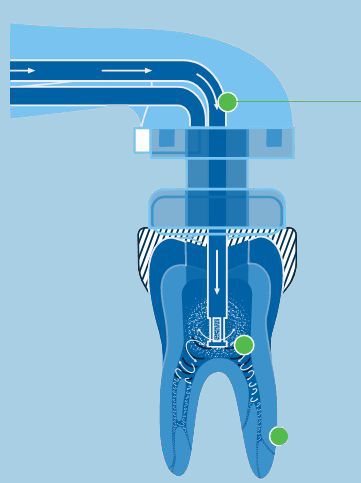
What has Fluid Dynamics to do With Root Canal
Advertisement
Scientists used computational fluid dynamics to determine the effect of temperature on root canal cleaning efficiency. Higher temperatures can, to a point, improve cleansing, but this benefit falls off if the temperature gets too high.
In Physics of Fluids, scientists from China and the U.S. report calculations with a model of the conical-shaped root canal inside a tooth. This cavity is usually filled with pulp. When the pulp becomes inflamed or infected, an endodontist removes the infected pulp, and then cleans, shapes and fills the canal. The apex is then sealed.

A crucial step in this common dental procedure is irrigation, or rinsing, of the root canal cavity with an antibacterial solution, such as sodium hypochlorite.
Efficient cleaning and successful destruction of any bacteria or other in the cavity depend on the penetration and cleaning ability of the irrigation fluid.
The computational investigation used a structured mesh as a model of the conical root canal cavity. More than 1 million cells in the mesh completely and accurately described both the root canal and the side-vented needle through which the hypochlorite solution is injected. Fluid dynamics equations were used to model flow of the hypochlorite solution.
The scientists varied the fluid velocity, temperature and input power to determine the most efficient cleansing technique. As expected, higher fluid velocities lead to better cleansing. Perhaps counterintuitively, cleansing efficiency is higher on the wall behind the needle vent.
Advertisement
"The effective area on the root canal wall, in which the shear stress exceeds the critical value to clean the wall, is usually larger behind the needle outlet than in front of it," said author Hanhui Jin.
The maximum shear stress also usually occurs on the wall behind the needle outlet, Jin explained.
The investigators also looked at the effect of temperature on cleansing. They considered four different temperatures: 22 Celsius, which is room temperature; 37 C, which is body temperature; and two higher temperatures of 45 C and 60 C. Temperatures above 60 C are painful for the patient and tend to cause root canal damage.
Increasing the temperature to 45 C, while holding the fluid velocity fixed, improved the depth of cleansing and the cleansing span across the canal's width, but further increases in temperature beyond 45 C actually decreased the cleansing efficiency.
The investigators considered the effect of power consumption by the irrigation device. If the power consumption is held at a fixed value, the effect of temperature on cleansing efficiency is much more pronounced.
Advertisement
- Previous article
- Have you Ever Heard of the Batman Effect?
- Next article
- Discover Aesthetic Transparent Wood that is Better Than Glass
Advertisement
OTHER NEWS

Cobble, a dating decision-making app, receives $3 million in seed funding
BY Chris

The Mysterious Blue Hole Under Water
BY Carolyn

How to Name Genes With Excel
BY Gloria

USDA Is Fighting Against Vespa Mandarinia
BY Rebecca

How to Survive When Mobile Phone has no Reception
BY Norma

How to Know the Weight of Tyrannosaurus Rex?
BY Catherine
RECENT NEWS
-

PUBG Mobile Esports Generated 200 Million Hours of Viewing in 2020
-

Mario Kart Tour Races to $200M revenue and 200M Downloads
-

Game Acquisitions Expand Globally in Q1 2021 with 280 Deals Worth $39 Billion Surpassing That in 2020
-

Free Fire Shows Strong Momentum, with Its Revenue Overtaking PUBG Mobile in a Single Market for Q1 2021
-

The Games Fund Launched a $50 Million Early Investment Fund to Invest in American and European Companies
-

How to Download and Install Wyze App for Free?
 1
1 1
1